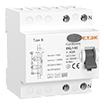| Poles |
Reference No. |
Specification |
| 1P |
EKLR-1610-230/110 |
16A 1NO 1P 1Module 230VAC/110VDC |
| EKLR-1610-130/48 |
16A 1NO 1P 1Module 130VAC/48VDC |
| EKLR-1610-48/24 |
16A 1NO 1P 1Module 48VAC/24VDC |
| EKLR-1610-24/12 |
16A 1NO 1P 1Module 24VAC/12VDC |
| EKLR-1610-12/6 |
16A 1NO 1P 1Module 12VAC/6VDC |
| EKLR-161C-230/110 |
16A Single knife and double throw contact 1P 1Module 230VAC/110VDC |
| EKLR-161C-130/48 |
16A Single knife and double throw contact 1P 1Module 130VAC/48VDC |
| EKLR-161C-48/24 |
16A Single knife and double throw contact 1P 1Module 48VAC/24VDC |
| EKLR-161C-24/12 |
16A Single knife and double throw contact 1P 1Module 24VAC/12VDC |
| EKLR-161C-12/6 |
16A Single knife and double throw contact 1P 1Module 12VAC/6VDC |
| 2P |
EKLR-1620-230/110 |
16A 2NO 2P 1Module 230VAC/110VDC |
| EKLR-1620-130/48 |
16A 2NO 2P 1Module 130VAC/48VDC |
| EKLR-1620-48/24 |
16A 2NO 2P 1Module 48VAC/24VDC |
| EKLR-1620-24/12 |
16A 2NO 2P 1Module 24VAC/12VDC |
| EKLR-1620-12/6 |
16A 2NO 2P 1Module 12VAC/6VDC |
| EKLR-1611-230/110 |
16A 1NC+1NO 2P 1Module 230VAC/110VDC |
| EKLR-1611-130/48 |
16A 1NC+1NO 2P 1Module 130VAC/48VDC |
| EKLR-1611-48/24 |
16A 1NC+1NO 2P 1Module 48VAC/24VDC |
| EKLR-1611-24/12 |
16A 1NC+1NO 2P 1Module 24VAC/12VDC |
| EKLR-1611-12/6 |
16A 1NC+1NO 2P 1Module 12VAC/6VDC |
| EKLR-162C-230/110 |
16A Two sets of single - knife double - throw contacts 2P 2Module 230VAC/110VDC |
| EKLR-162C-130/48 |
16A Two sets of single - knife double - throw contacts 2P 2Module 130VAC/48VDC |
| EKLR-162C-48/24 |
16A Two sets of single - knife double - throw contacts 2P 2Module 48VAC/24VDC |
| EKLR-162C-24/12 |
16A Two sets of single - knife double - throw contacts 2P 2Module 24VAC/12VDC |
| EKLR-162C-12/6 |
16A Two sets of single - knife double - throw contacts 2P 2Module 12VAC/6VDC |
| 3P |
EKLR-1630-230/110 |
16A 3NO 3P 2Module 230VAC/110VDC |
| EKLR-1630-130/48 |
16A 3NO 3P 2Module 130VAC/48VDC |
| EKLR-1630-48/24 |
16A 3NO 3P 2Module 48VAC/24VDC |
| EKLR-1630-24/12 |
16A 3NO 3P 2Module 24VAC/12VDC |
| EKLR-1630-12/6 |
16A 3NO 3P 2Module 12VAC/6VDC |
| EKLR-1621-230/110 |
16A 2NO+1NC 3P 2Module 230VAC/110VDC |
| EKLR-1621-130/48 |
16A 2NO+1NC 3P 2Module 130VAC/48VDC |
| EKLR-1621-48/24 |
16A 2NO+1NC 3P 2Module 48VAC/24VDC |
| EKLR-1621-24/12 |
16A 2NO+1NC 3P 2Module 24VAC/12VDC |
| EKLR-1621-12/6 |
16A 2NO+1NC 3P 2Module 12VAC/6VDC |
| 4P |
EKLR-1640-230/110 |
16A 4NO 4P 2Module 230VAC/110VDC |
| EKLR-1640-130/48 |
16A 4NO 4P 2Module 130VAC/48VDC |
| EKLR-1640-48/24 |
16A 4NO 4P 2Module 48VAC/24VDC |
| EKLR-1640-24/12 |
16A 4NO 4P 2Module 24VAC/12VDC |
| EKLR-1640-12/6 |
16A 4NO 4P 2Module 12VAC/6VDC |
| EKLR-1631-230/110 |
16A 3NO+1NC 4P 2Module 230VAC/110VDC |
| EKLR-1631-130/48 |
16A 3NO+1NC 4P 2Module 130VAC/48VDC |
| EKLR-1631-48/24 |
16A 3NO+1NC 4P 2Module 48VAC/24VDC |
| EKLR-1631-24/12 |
16A 3NO+1NC 4P 2Module 24VAC/12VDC |
| EKLR-1631-12/6 |
16A 3NO+1NC 4P 2Module 12VAC/6VDC |
| EKLR-1622-230/110 |
16A 2NO+2NC 4P 2Module 230VAC/110VDC |
| EKLR-1622-130/48 |
16A 2NO+2NC 4P 2Module 130VAC/48VDC |
| EKLR-1622-48/24 |
16A 2NO+2NC 4P 2Module 48VAC/24VDC |
| EKLR-1622-24/12 |
16A 2NO+2NC 4P 2Module 24VAC/12VDC |
| EKLR-1622-12/6 |
16A 2NO+2NC 4P 2Module 12VAC/6VDC |











 Operation
Operation





